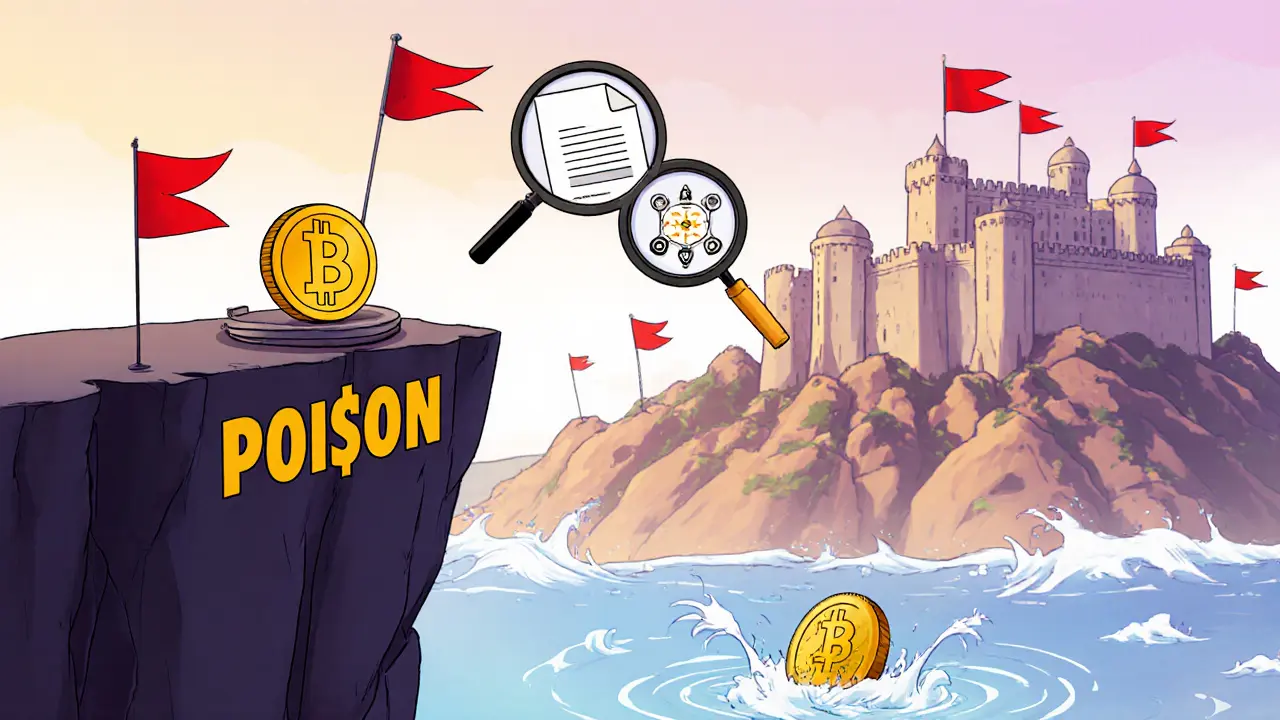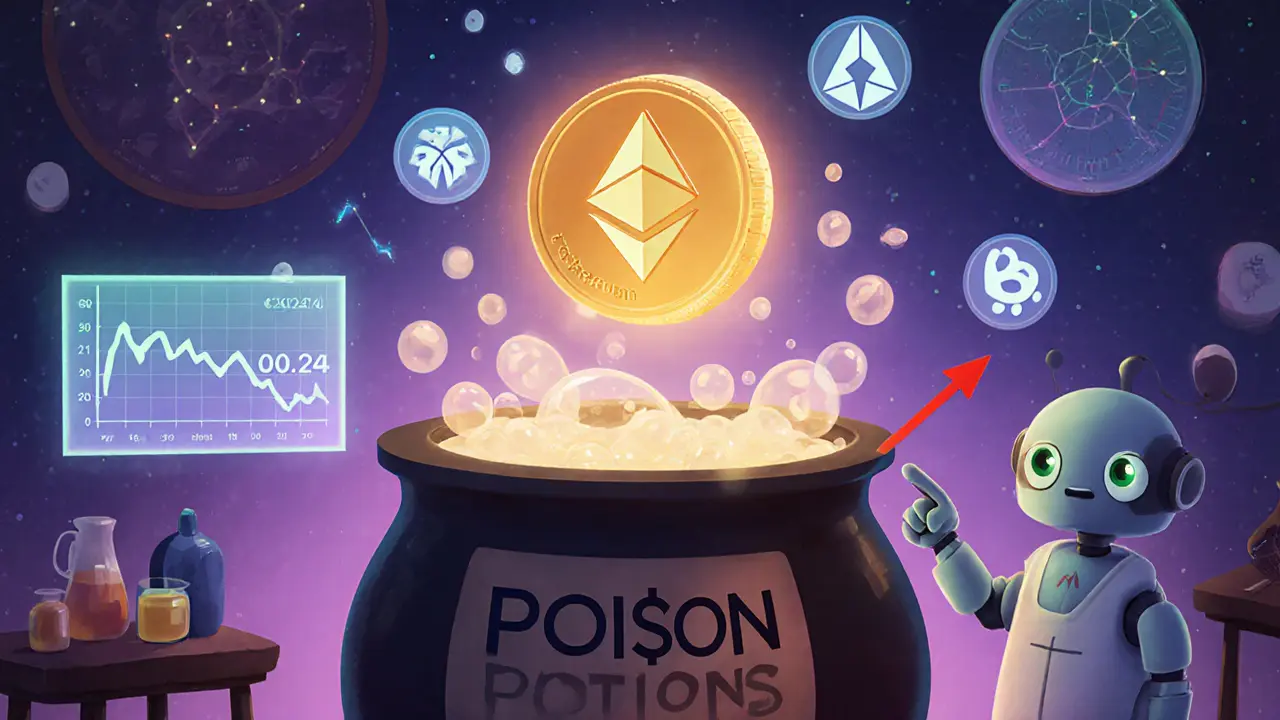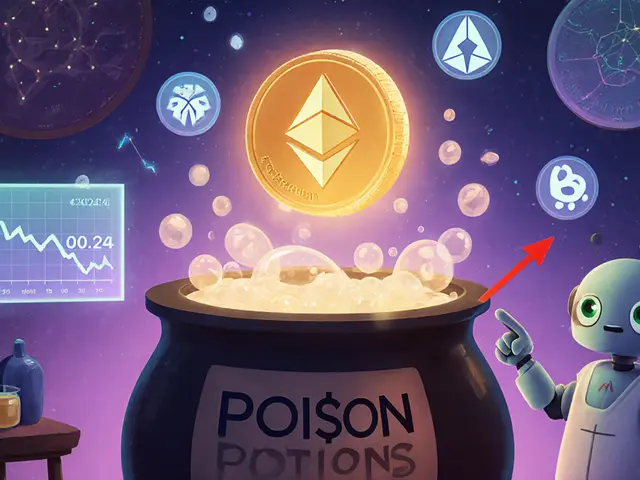POI$ON Liquidity Risk Calculator
Calculate Price Impact
Based on current POI$ON market data:
Current Market Cap: $23,000
Current Price: $0.0024
24h Volume: $100
Quick Takeaways
- Poison Finance (POI$ON) is a micro‑cap DeFi token that lives on Ethereum, Arbitrum and Binance Smart Chain.
- It aims to issue synthetic assets called “Potions” but provides almost no public road‑map or audit.
- Market cap hovers around $23K, price is about $0.0024, and daily volume is under $120.
- Liquidity is extremely thin and the token is not listed on major exchanges.
- Investors should treat POI$ON as a high‑risk speculative token with a high chance of becoming worthless.
What Is Poison Finance?
When you see the name Poison Finance (ticker POI$ON) is a decentralized finance token that claims to power a multichain synthetic‑asset protocol, the first question is “does it do anything useful?” The short answer: it attempts to let holders stake, earn rewards, and mint synthetic assets-referred to as “Potions”-but the public code, audits, or detailed documentation are missing.
How Does the Protocol Work?
The protocol is built on three blockchains: Ethereum, Arbitrum (a Layer‑2 scaling solution), and Binance Smart Chain. Each network hosts an ERC‑20 compatible version of POI$ON, allowing users to move the token across chains using bridges, although no official bridge is documented.
The core feature is the issuance of synthetic assets-dubbed “Potions.” In theory, a user locks POI$ON as collateral, the protocol mints a new token representing a real‑world or crypto‑derived asset, and the user can trade that synthetic token on a DEX. In practice, no public contract addresses for these synthetic assets have been listed, and there is no transparent description of the minting ratios or liquidation mechanisms.
A second advertised feature is staking. According to a Bitget article, POI$ON holders can “stake, earn, and win tokens,” but the staking contract address, reward rate, and lock‑up periods are not publicly verified. This makes the staking claim feel more like marketing copy than a functional product.

Market Snapshot (October142025)
Below is a snapshot of the most recent on‑chain and market data. All numbers are pulled from reputable aggregators and are rounded for readability.
| Metric | Value |
|---|---|
| Current Price (USD) | $0.0024 |
| All‑Time High | $2.01 (2025‑03‑23) |
| Circulating Supply | 8,770,092 POI$ON |
| Market Capitalization | ≈ $23,000 |
| 24‑Hour Volume | $80-$115 (average) |
| Rank (global market cap) | #10,235 |
| Supported Chains | Ethereum, Arbitrum, BSC |
The token has lost more than 99% of its value since the March peak, with 90‑day price declines exceeding 80%. Daily liquidity is so low that even a $100 trade would move the price by several percent.
How to Acquire and Use POI$ON
Because POI$ON is not listed on Binance, KuCoin, or any other major exchange, you must rely on smaller decentralized exchanges (DEXs). The typical steps look like this:
- Set up a wallet that supports Ethereum‑compatible tokens (e.g., MetaMask, Trust Wallet).
- Add the POI$ON contract address for the chain you intend to use. The most common address is the Ethereum version; you can find it on the project’s GitHub (if live) or a reputable block explorer.
- Buy a base token such as ETH, BNB, or USDT on a large exchange, then bridge it to the target chain if needed.
- Connect your wallet to a DEX that lists POI$ON (e.g., Uniswap v3 for Ethereum, SushiSwap on Arbitrum, or PancakeSwap on BSC).
- Swap your base token for POI$ON, confirm the transaction, and wait for the blockchain to finalize.
- If you want to stake, locate the staking contract address (usually shared on the project’s official Telegram or Discord) and approve the token spend before depositing.
Because the token’s liquidity is so thin, you may need to accept a high slippage setting (often 5-10%). This further erodes the effective price you pay.
Risks and Red Flags
Every crypto investment carries risk, but POI$ON has a cluster of warning signs that make it especially precarious:
- Micro‑cap profile: A $23K market cap means even a single large sell order can wipe out the whole market.
- No audit or security report: None of the major security firms have published a review of the contracts.
- Zero listing on major exchanges: Binance and KuCoin both state the token is not listed, limiting exposure and raising credibility concerns.
- Missing development transparency: There is no public roadmap, team bios, or code repository linked from the official channels.
- Extreme price decay: An 80% drop over the last 90days shows sellers are far outnumbering buyers.
- Regulatory uncertainty: Synthetic assets often attract regulator scrutiny; a token without clear compliance could be delisted or frozen.
In short, treat POI$ON as speculative junk rather than a reliable store of value.

Comparison with a Typical DeFi Token
To put POI$ON into perspective, here’s a quick side‑by‑side of its key attributes versus a well‑known DeFi token like Uniswap (UNI).
| Attribute | POI$ON | UNI |
|---|---|---|
| Market Cap | ≈ $23K | ≈ $7.5B |
| 24‑Hour Volume | $80-$115 | $1.2B |
| Liquidity Pools | Very thin, few DEX listings | Hundreds of pools across major DEXs |
| Audit Status | None publicly available | Audited by multiple firms (e.g., OpenZeppelin) |
| Utility | Claimed staking & synthetic assets; unproven | Governance, fee sharing, LP incentives |
The contrast is stark: POI$ON operates in a vacuum with negligible liquidity, while UNI is a cornerstone of DeFi with deep markets and audited code.
Frequently Asked Questions
What blockchain networks does POI$ON run on?
POI$ON is deployed on Ethereum, Arbitrum (Layer‑2), and Binance Smart Chain. Each version is an ERC‑20‑compatible token, so you can interact with it using any wallet that supports those chains.
Is there an official audit of the POI$ON contracts?
No reputable audit report has been published. The lack of a security review is a major red flag for investors.
Where can I buy POI$ON?
Because it’s not listed on major exchanges, you must use decentralized exchanges that list the token. Typical steps involve adding the contract address to a wallet, then swapping a base token (ETH, BNB, USDT) for POI$ON on platforms like Uniswap, SushiSwap, or PancakeSwap.
What are “Potions” in the Poison Finance ecosystem?
Potions are the synthetic assets the protocol claims to mint when users lock POI$ON as collateral. No public contract addresses or detailed mechanics have been shared, so the feature is largely speculative.
Is POI$ON a good long‑term investment?
Given its micro‑cap size, near‑zero liquidity, lack of audits, and steep price declines, POI$ON carries a very high risk of loss. It is not recommended for most investors.
Next Steps for Interested Readers
If you still want to explore POI$ON despite the risks, follow this quick checklist:
- Verify the exact contract address on a trusted block explorer (Etherscan, BscScan, or Arbiscan).
- Set up a hardware‑or‑software wallet with the appropriate network configuration.
- Test a tiny transaction (e.g., $0.01 worth) on a DEX to confirm the token moves as expected.
- Keep the amount you allocate to POI$ON below a level you can comfortably lose.
- Monitor community channels (Telegram, Discord) for any updates on audits or roadmap moves.
Remember, in the crypto world the best protection is a clear understanding of what you own. If the signals keep pointing to emptiness, walking away is often the smartest move.


Comments
If you’re scouting micro‑caps for a wild ride, POI$ON is the kind of token that pops up on the radar because of its absurdly low market cap. The token sits on Ethereum, Arbitrum and BSC, but its liquidity pool is practically a puddle. A $100 trade can shift the price by several percent, so volatility isn’t even the right word. Treat it like a gamble you’d only play with money you’re ready to lose.
One could argue that POI$ON embodies the spirit of speculative curiosity that fuels the crypto frontier 😊. While the token claims to mint synthetic “Potions,” the mechanics remain hidden behind a veil of anonymity. This opacity invites a philosophical question about trust versus transparency in decentralized finance. In the end, the allure lies more in the narrative than in any concrete utility. If you enjoy chasing shadows, this might be your next adventure.
Liquidity is basically nonexistent.
From a practical standpoint, you should start by verifying the exact contract address on Etherscan or BscScan; copy‑paste errors are a common way to lose funds. Next, pull a tiny amount of USDC or ETH onto the appropriate chain and set your slippage tolerance to at least 5‑10 % – the market can’t absorb larger orders without severe price impact. Once the token arrives in your wallet, consider doing a test swap of $0.01 to see if the transaction goes through without excessive fees. If that works, you can decide whether you want to commit a larger amount, but keep the total exposure under what you can comfortably lose. Remember, there’s no audit, so the smart contracts could contain hidden backdoors. Monitoring community channels like the official Discord for any red‑flag announcements is also wise. Finally, consider using a hardware wallet for added security when interacting with unknown contracts.
Really? A token with $23K market cap and no audits – elementary risk. Stop chasing fairy‑tale promises.
Contemplating the nature of value, POI$ON raises the question of whether price is derived from utility or pure speculation. Its listed features sound promising, yet the absence of verifiable code turns them into philosophical musings. In the realm of finance, belief often shapes reality, but belief without evidence can be perilous. If one embraces the uncertainty, the token can be a study in market psychology. Otherwise, the prudent path is to stay away.
Listen up: POI$ON is a textbook case of a high‑risk, low‑reward gamble that could implode at any moment! The liquidity is so thin that a single whale could tank the price, leaving retail investors with dust. No audit, no roadmap, and a market cap that barely covers a decent pizza – that’s the red flag parade. If you value your capital, keep it in assets with proven security and active development. Otherwise, if you thrive on adrenaline, consider the token as a fleeting thrill. Just make sure you’re prepared to watch it disappear.
Honestly, the whole “synthetic potions” gimmick feels like a circus act with no real tricks.
When you peel back the layers, POI$ON appears to be more of a speculative curiosity than a functional protocol. Its multi‑chain deployment is technically interesting, but without transparent documentation the effort seems hollow. Investors often chase novelty, yet novelty without substance rarely endures. The token’s price history, a plunge of over 99 % from its all‑time high, serves as a stark reminder of market volatility. In short, treat it as a cautionary tale rather than a portfolio cornerstone.
From a formal perspective, the POI$ON project suffers from a grievous lack of verifiable security assurances. The absence of a reputable audit raises profound concerns regarding potential vulnerabilities within its smart contracts. Moreover, the token’s micro‑cap status renders it susceptible to manipulation by entities possessing modest capital. While the notion of “Potions” intrigues, its opaqueness undermines any substantive confidence. Consequently, a prudent investor would deem this venture exceptionally hazardous.
As a citizen of our great nation, I must stress that investing in such an unvetted token borders on fiscal irresponsibility. The sheer lack of transparency is an affront to the principles of sound financial stewardship. One should redirect capital toward projects that reflect national pride and proven stability.
Just taking a step back, the whole POI$ON thing feels like a textbook example of hype over substance. The community chatter is loud, but the actual tech seems thin. It’s a reminder to always dig deeper before jumping on a bandwagon.
Hey folks, if you’ve got a spare few bucks and love a wild ride, POI$ON could be the adrenaline boost you need! Just remember to keep your expectations realistic 😊.
Whilst the presentation of POI$ON is decorous, the underlying premise suffers from a noticeable paucity of data; very few approvable points are evident. It is recommended you approach with skepticism, especially given the scantouvred audit trails. The risk, in my opinion, outweighs potential benefit.
I get why some people are curious about POI$ON, but let’s keep the conversation inclusive. If you decide to explore it, set a hard cap on how much you’re willing to lose. Share any findings with the community so we can all learn together. Remember, we’re all here to help each other navigate these risky waters.
Yo, this POI$ON thing is straight up the wild west of DeFi, complete with dust‑up vibes and zero‑day mysteries. The token’s liquidity is a ghost town, and the “synthetic potions” jargon reads like a marketing spellbook. No audit? That’s a red flag flashing louder than a TV ad. If you’re into high‑octane speculation, strap in, but don’t be blindsided when the price tank‑sinks. Bottom line: treat it like a side‑quest, not the main storyline.
Oh wow, another “ground‑breaking” token with absolutely no fundamentals!!! 🙄 Clearly, the crypto market’s innovation engines are working overtime. If you’re looking for a safe haven, keep walking. If you enjoy watching money evaporate, buckle up!!!
Nice to see another token promising miracles while delivering nothing.
POI$ON – a glittering bubble or a legit project? Hardly any substance, just hype.
When considering a token like POI$ON, it’s valuable to pause and reflect on your own risk tolerance. Start with a micro‑investment and observe how the market reacts. Sharing those observations can help others make informed decisions.
Alright, let’s keep it simple: POI$ON is a high‑risk gamble. If you love drama, it’ll give you plenty of it. Just don’t blame the community when it crashes. Keep your stakes tiny and your expectations low. That way, you can enjoy the ride without the heartbreak.
In the grand tapestry of decentralized finance, POI$ON emerges as a cautionary motif, weaving together the threads of ambition and opacity. Its purported utility – the minting of synthetic "Potions" – is presented without the scaffolding of transparent code or audited contracts, leaving observers to speculate on the alchemy beneath. The token's market cap, a modest $23,000, renders it vulnerable to price manipulation, a fact starkly underscored by its historical plunge of over ninety percent from its all‑time high. Liquidity, the lifeblood of any tradable asset, is alarmingly thin; a modest $100 transaction can precipitate a multi‑percentage swing, betraying the fragility of its market depth. Moreover, the absence of listings on major exchanges compounds the difficulty of liquidating positions, channeling traders into fragmented DEX ecosystems where slippage fees dominate. While the multi‑chain deployment across Ethereum, Arbitrum, and Binance Smart Chain suggests a degree of technical ambition, the lack of a documented bridge mechanism invites further uncertainty. Potential investors must also grapple with the regulatory haze that surrounds synthetic asset platforms, where compliance frameworks remain nascent and enforcement unpredictable. Against this backdrop, the token's staking promises appear as glossy embellishments, unsubstantiated by verifiable reward rates or contract addresses, thus eroding confidence in any yield assertions. The community discourse, populated by sporadic updates and promotional material, offers scant insight into developmental milestones or governance structures. Consequently, the risk–reward calculus tilts heavily toward peril, with the specter of total loss looming large. In essence, POI$ON serves as an illustrative case study of micro‑cap speculative ventures that thrive on hype while neglecting foundational solidity. Prospective participants would be well‑advised to conduct rigorous due diligence, limiting exposure to capital they can afford to forfeit. Ultimately, the token's future hinges upon whether its architects can transition from enigmatic promises to tangible deliverables, a transformation that remains, at present, more aspiration than reality.
While the previous analysis is thorough, it is essential to emphasize that speculative assets like POI$ON demand a disciplined approach. Allocate only a negligible portion of your portfolio, and monitor the token's activity for any red flags. This measured stance safeguards against undue exposure.